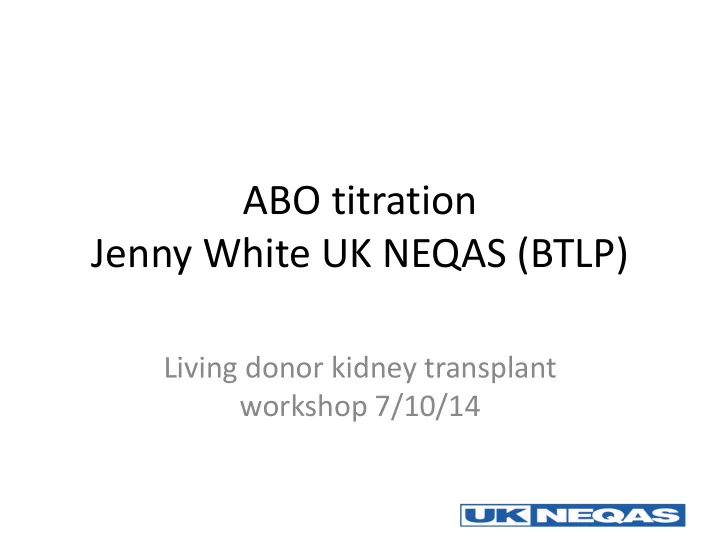

ABO titration Jenny White UK NEQAS (BTLP) Living donor kidney transplant workshop 7/10/14
EQA Process Action Results • Plan • Analyse • Test • Review exercise results exercise results / • Prepare • Report learning • Report samples points results Exercise Report
UK NEQAS Exploratory pilot - 2009 ?Variability in practice ? Need for EQA Recruited 52 participants from 15 countries Belgium Netherlands 26 UK Cyprus Norway 26 non-UK Denmark Portugal 20 ABOi renal transplant Eire Oman 13 BMT / HSCT Finland Sweden 11 ABO HDN Iceland Tunisia 5 Others Israel UK
Titration method Variables • Technology (tubes, CAT etc.) • End point • Source of red cells used • QC - titration of previous sample • Testing method (IAT, DRT etc) Variables within technology • Red cell diluent • Plasma / red cell ratio • Red cell concentration • Incubation time 2009 - huge variation between and within technology
Measuring IgG? IgM? • Generalisations IgM IgG Cold (4 o C) Warm (37 o C) Direct agglutination at room temperature IAT
Anti-A and anti-B • IAT result = IgG (+ IgM) (used by 13/14 UK renal Tp centres) • DRT result = IgM (+ IgG) • IAT (DTT treated plasma) = IgG
2009 example UK NEQAS results
Quantifying antibody concentration Aubuchon et al 37 0 C - Gel - AHG ° Application of Aubuchon et al
UK NEQAS ABOT Pilot 2010 – to date • Aim = to support ABOi transplant • ABOi pilot EQA Scheme guided by ABOi SAG • Development of standard technique – IT and DRT DiaMed, prescribed volumes, end point etc. – facilitate EQA – transferrable results across centres • Developing ABO ‘standards’ with NIBSC • Highlight variability in titres to clinicians
ABOi pilot 2012-13 4 exercises per year • 3 plasma samples for titration vs. A cells provided • Replicate samples in 3 consecutive exercises • Duplicate sample within an exercise • Reporting individual result to each lab and method medians • Comparing in-house and standard techniques • Questions on clinical use of results • 69 labs (37 UK), 38 supporting ABOi transplant and 31 others
Example individual results Inter laboratory results spanned a wide range, e.g.: 512 – 32000 by IAT for a high titre sample ABOT4 P1 (standard median 2048) 8 – 128 by IAT for low titre sample ABOT3 P3 (standard median 16)
Replicate samples over 3 exercises % results for replicate samples the same or within 1 or more dilution • 92% sets of standard IAT results within 1 DD cf. 66% IH IAT. • 51% sets of standard DRT results within 1 DD cf. 68% DRT IH • Only 1/3 sets of IAT DTT treated plasma was within 1 DD
Duplicate samples in the same exercise 95.5% results by DRT and 98.8% by IAT were within one dilution 78% of IAT (non-DTT) results and 72% DRT results identical
In-house median vs. std median (IAT) The IAT BioVue median result was higher than that for the IAT ‘standard technique’ ( DiaMed) in 11/12 (92%) samples • Median for each sample by each IH technology assigned a score of 1 for each dilution above or -1 for each dilution below the standard median. • Where median between two dilutions, results either side assigned 0.5. • Scores totalled to give a cumulative score.
Clinical use of results • 14 UK transplant centres surveyed in 2013 • Maximum patient ABO antibody titres • 128-4096 for acceptance ABOi renal transplant programmes • 2-16 for a transplant to go ahead on the day Example of IAT results (for a single EQA sample) submitted by laboratories providing ABO titration results to these centres • No correlation result with cut-off values
2012/13 ABOT Pilot – outcomes (1) • Still variation in in-house methodology • Increasing use of standard technique - EQA and clinical • Measurement of IgG / IgM? – DRT, IAT, IAT DTT treated • Errors in A subtyping (one exercise) – 2 labs supporting ABOi programs mistyped A 2 cells as A 1
2012/13 ABOT Pilot – outcomes (2) • IAT more reproducible than DRT • Standard IAT results more reproducible than IH IAT results • Std. results tighter range (closer to method median) than Tube • BioVue IAT titre consistently higher than std. IAT titre
2012/13 ABOT Pilot – outcomes (3) Variation in practice (14 UK centres - ABOi renal Tp) • Max titre for admission to ABOi program (128 – 4096) • Max titre for suitability on day of Tp (2-16) • ‘Cut - offs’ values do not correlate with EQA titres
Conclusions • Need EQA • Need reference preparations for anti-A and anti-B • Need standardisation to make results transferrable between centres and to allow equitable access to ABOi transplant programmes 1 • Need to find a safe way to implement standardisation 1 No progress in ABO titer measurement: time to aim for a reference? A. Bentall et al, Letter to the editor, Transplantation, volume 97, number 3, February 15 2014
Recommend
More recommend